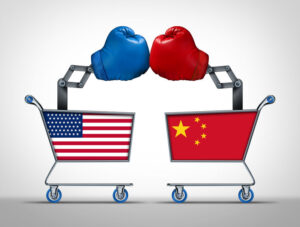Sep
8
The Truth About Tariffs
“Do tariffs defy the laws of supply and demand and lift our standard of living?” — opening question in “Separating Tariff Facts from Tariff Fictions” by Erica York, Cato Institute

Every once in awhile, the issue of tariffs comes up in the news. Even with my limited knowledge of economics and tariffs, I know that, even if imposing select tariffs sounds like good economic policy for America, it is generally a bad idea. (Most economists agree.)
So, I was very disappointed when the Trump administration decided a few years ago to punish China with tariffs on things like steel, washing machines, and Chinese products in general. (Blame Jared Kushner for introducing his father-in-law to pro-tariff economist Peter Navarro.) Unfortunately, the Biden administration has kept these tariffs in place.
Not long ago, I came across a lengthy article by Erica York from the Cato Institute that examines the whos, whats, whys, and hows of tariffs, particularly in U.S. history. The article begins with the following five bullet points, which summarize the major takeaways:
o A tariff is a tax on foreign goods that raises revenue for the imposing government. Motivations for imposing tariffs range from revitalizing local industries to addressing unfair trade.
o Importers legally pay US tariffs, but their economic burden (i.e., who really pays) depends: It can be borne by American consumers, businesses, and exporters, by foreigners exporting to the United States, or by some combination of these groups.
o Economists use a variety of methods to analyze how tariffs affect protected companies, consumers, importing firms, exporters, and our economy overall. They generally find that tariffs benefit some but hurt far more others, thus lowering overall living standards and economic growth. Tariff-protected industries also rarely (if ever) become stronger. [Emphasis mine.]
o Recent empirical evidence indicates the new US tariffs imposed in 2018 and 2019 were almost entirely passed on to US consumers, resulting in higher prices and reduced export growth.
o Tariffs often lead to cascading protectionism and create a fertile ground for corruption. The 2018–2019 tariffs on China led to a complex process of exclusion requests, lobbying, and retaliatory tariffs, demonstrating the multifaceted harms of protectionist measures. [Emphasis mine.]
Although the article is not solely about Trump’s tariff policy, it does come up throughout. Here are a few relevant quotes from that discussion:

“As Adam Posen, president of the Peterson Institute for International Economics, explains, over the past two decades, the American government has been increasingly insulating the economy from foreign competition and withdrawing from global trade, including through higher tariffs. The Trump administration accelerated that trend with extensive use of delegated powers to impose new tariffs….
Recent empirical evidence, using a variety of methods, indicates near complete pass-through of the 2018–2019 tariffs to US consumers. Mary Amiti, Stephen J. Redding, and David Weinstein found that the full burden passed through, costing US consumers and the firms that import foreign goods an additional $3 billion per month in added tax costs and $1.4 billion in deadweight loss (or lost income) as depicted in Figure 3….
Across the different data sources and methodologies, the main takeaway from recent empirical work is that US consumers, including business consumers and particularly poorer consumers, have shouldered the burden of US tariffs through higher prices and reduced export growth, and this burden far outweighs any economic benefits of tariffs….
The experts’ predictions proved correct. As Daniel Griswold and Andreas Freytag documented in a 2023 Cato Institute paper and as Figure 6 shows, the 2018–2019 tariffs imposed by the Trump administration and since maintained by the Biden administration ‘had no discernible impact on the relative size of the trade deficit’; if anything, the deficit actually increased slightly versus where it was at the end of the Obama administration.”
If you aren’t inclined to read the entire article but want a bit more than I provided above, I suggest at least reading the first two sections — “Introduction” and “What Is a Tariff, and What Does It Do?” (which are brief) — and skimming the rest. That’s what I did. Here is York’s conclusion:
“American history provides an abundance of examples of politicians using tariffs to protect domestic industry. Taken together, the examples show that tariffs do not generate higher levels of employment or production for the economy overall; they do not ensure the long-term health of the industries being protected or fundamentally alter the trade balance; and they serve not the strategic interests of the nation but the parochial interests of politicians who get to enrich preferred companies and workers by imposing diffuse and mostly hidden costs on the rest of the US economy.”
That about sums it up, sports fans.
Don’t get me wrong. Despite this particular issue, I will be casting my vote for Trump/Vance come November. As usual, it’s a matter of which party will do the most good and the least bad. But, if Trump returns to the Oval Office, I sincerely hope his economic advisors turn him around on this tariff nonsense.















